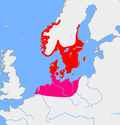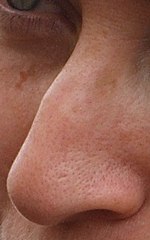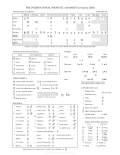A nasal vowel is a vowel that is produced with a lowering of the soft palate (or velum) so that the air flow escapes through the nose and the mouth simultaneously...
11 KB (1,232 words) - 15:14, 9 August 2024
quadrilateral IPA vowel diagram on the right. There are additional features of vowel quality, such as the velum position (nasality), type of vocal fold...
57 KB (7,108 words) - 11:30, 29 July 2024
Nasalization (redirect from Nasal accent)
Many languages have nasal vowels to different degrees, but only a minority of world languages around the world have nasal vowels as contrasting phonemes...
11 KB (1,253 words) - 09:06, 21 August 2024
Portuguese phonology (section Nasal vowels)
consonant hereafter denoted as /ɲ/ is realized as a nasal palatal approximant [j̃], which nasalizes the vowel that precedes it: ninho ([ˈnij̃u ~ ˈnʲij̃u ~ ˈɲij̃u]...
91 KB (9,367 words) - 19:50, 23 July 2024
French phonology (redirect from French vowels)
Standard French. Notable phonological features include its uvular r, nasal vowels, and three processes affecting word-final sounds: liaison, a specific...
54 KB (5,204 words) - 13:45, 6 August 2024
dental consonants. Outside this environment the nasality is spread over the vowel or become a nasal diphthong (mambembe [mɐ̃ˈbẽjbi], outside the final...
21 KB (2,444 words) - 14:20, 16 August 2024
Elfdalian (section Nasal vowel sounds)
preserve nasal vowels from Proto-Norse; all other Nordic dialects with nasal vowels have developed them later as a result of the loss of a nasal consonant:...
38 KB (3,322 words) - 13:39, 25 June 2024
Guarani language (section Nasal harmony)
layout feature of glyph composition. Only stressed nasal vowels are written as nasal. If an oral vowel is stressed, and it is not the final syllable, it...
47 KB (4,087 words) - 23:43, 21 July 2024
Yoruba language (section Vowels)
with SEY. Its vowel system is the most traditional of the three dialect groups, retaining nine oral-vowel contrasts, six or seven nasal vowels, and an extensive...
55 KB (5,214 words) - 06:45, 10 August 2024
Proto-Germanic language (section Nasal vowels)
Proto-Germanic nasal vowels were joined in Old Norse by nasal vowels from other sources, e.g. loss of *n before s. Modern Elfdalian still includes nasal vowels that...
130 KB (12,136 words) - 12:36, 5 August 2024
Polish phonology (section Nasal)
preserved nasal sounds that existed in Proto-Slavic. However, recent sources present for modern Polish a vowel system without nasal vowel phonemes, including...
81 KB (7,446 words) - 20:58, 26 July 2024
The mid central vowel (also known as schwa) is a type of vowel sound, used in some spoken languages. The symbol in the International Phonetic Alphabet...
31 KB (1,832 words) - 06:50, 20 August 2024
Human nose (redirect from Nasal ridge)
nasal cavity, contains specialised olfactory cells responsible for this function. The nose is also involved in the function of speech. Nasal vowels and...
78 KB (9,094 words) - 20:54, 8 August 2024
each system. This may be a vowel such as /a/ (hiragana あ); a consonant followed by a vowel such as /ka/ (か); or /N/ (ん), a nasal sonorant which, depending...
52 KB (4,207 words) - 18:08, 9 August 2024
nosinė, "nasal e") is a letter in the Polish, Lithuanian, and Dalecarlian alphabets. It is also used in Navajo to represent the nasal vowel [ẽ] and Kensiu...
8 KB (688 words) - 00:59, 29 May 2024
Romance languages (section Vowel prosthesis)
any nasal consonants, and nasal consonants not immediately followed by a vowel were eventually dropped. In French, nasal vowels before remaining nasal consonants...
170 KB (16,200 words) - 00:19, 23 August 2024
International Phonetic Alphabet (redirect from IPA vowels)
mean phonetic voicing, nor a vowel; for example, in VoQS ⟨Ṽ⟩ is "nasal voice" (that is, nasalization), not a nasal vowel as it would be read in IPA notation...
162 KB (15,792 words) - 01:40, 24 August 2024
Bru language (section Nasal vowels)
a preceding a breathy vowel sound in the Western Bru dialects. It can also be heard as nasal [h̃] when preceding a nasal vowel in the Western dialects...
14 KB (946 words) - 00:11, 11 January 2024
Portuguese orthography (section Vowels)
that a vowel is stressed and the quality of the accented vowel and, more precisely, its height: á, é, and ó are low vowels (except in nasal vowels); â,...
61 KB (6,130 words) - 07:47, 18 August 2024
Maninka language (section Vowels)
Vowel qualities are /i e ɛ a ɔ o u/. All may be long or short, oral or nasal: /iː eː ɛː aː ɔː oː uː/ and /ĩ ẽ ɛ̃ ã ɔ̃ õ ũ/. (It may be that all nasal...
6 KB (477 words) - 12:14, 9 July 2024
Back vowel Basis of articulation Bernd J. Kröger Bilabial click (ʘ) Bilabial consonant Bilabial ejective (pʼ) Bilabial flap (ⱱ̟) Bilabial nasal (m) Bilabial...
13 KB (1,196 words) - 14:10, 20 February 2024
Old Polish (section Loss of vowel length)
of a word), use of the letter ⟨ꟁ⟩ to write the short nasal vowel (⟨ꟁꟁ⟩ for the long nasal vowel), use of the letter ⟨g⟩ to write /j/, reserving ⟨q⟩ for...
34 KB (3,718 words) - 21:46, 16 August 2024
Edo language (section Vowels)
State and Bayelsa State, Nigeria. There are seven vowels, /i e ɛ a ɔ o u/, all of which may be long or nasal, and three tones. Edo has a rather average consonant...
12 KB (995 words) - 10:51, 19 August 2024
when there isn't space for chandrabindu.Anusvara can represent nasal vowel, homoorganic nasal or somethimes both. Anusvara is used in other languages using...
18 KB (1,650 words) - 06:59, 12 June 2024
Muscogee language (section Nasal vowels)
The vowel phonemes of Muscogee are as follows: There are three short vowels /i ɑ o/ and three long vowels /iː ɑː oː/. There are also the nasal vowels /ĩ...
33 KB (3,382 words) - 01:47, 8 July 2024
Japanese phonology (redirect from Moraic nasal)
every vowel is voiced.[citation needed] Vowels are nasalized before the moraic nasal /N/ (or equivalently, before a syllable-final nasal). Vowels adjacent...
186 KB (20,815 words) - 04:57, 21 August 2024
History of Proto-Slavic (section Vowel notation)
followed by a vowel) coalesced with a previous vowel, causing it to become nasalized (indicated with an ogonek diacritic below the vowel): The nasal element...
75 KB (9,348 words) - 01:20, 22 August 2024
Polish language (section Vowels)
The traditional set comprises 23 consonants and 9 written vowels, including two nasal vowels (ę, ą) defined by a reversed diacritic hook called an ogonek...
98 KB (8,873 words) - 10:34, 23 August 2024
Kaingang language (section Vowels)
ᶮɟ, ᵑɡ] when between a nasal and an oral vowel, as well as word-initially before oral vowels. Between an oral and a nasal vowel they are conversely realized...
17 KB (1,392 words) - 02:35, 30 July 2024
Osage language (section Vowel clusters and long vowels)
vowels tend to become nasalized adjacent to another nasal vowel or consonant when there is no intervening obstruent. On the other hand, final nasal vowels...
19 KB (1,886 words) - 14:54, 20 July 2024













